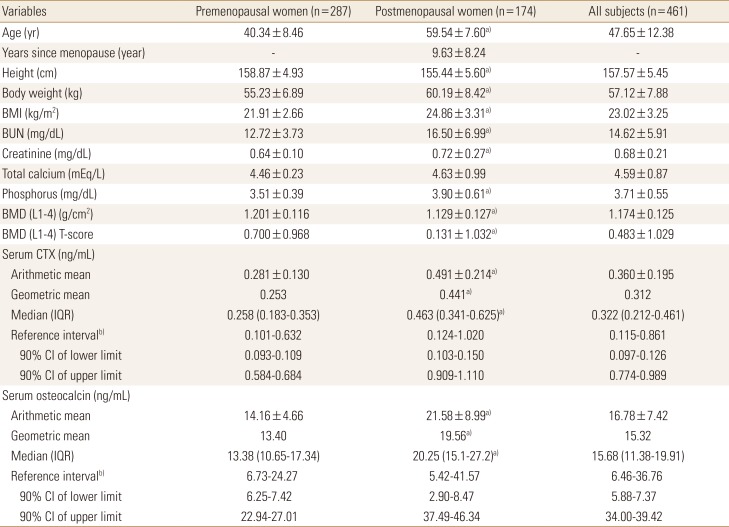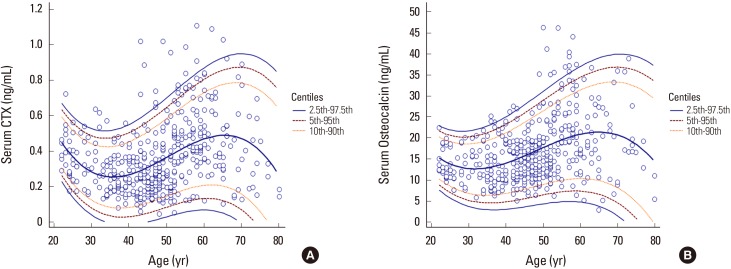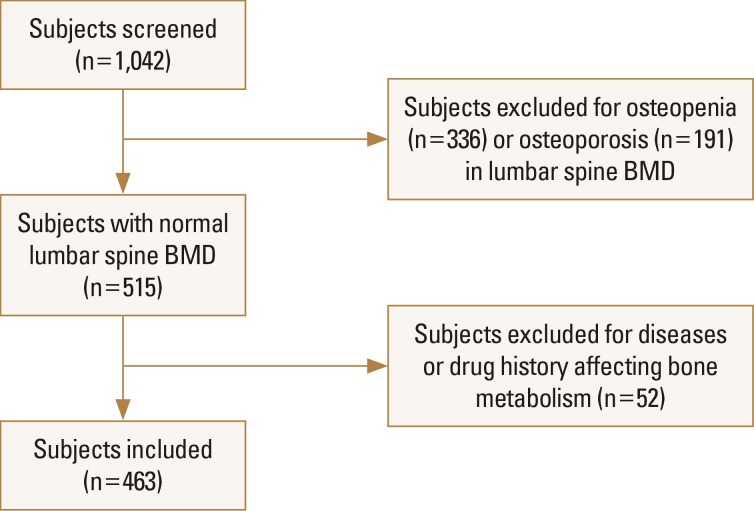1. Garnero P, Shih WJ, Gineyts E, et al. Comparison of new biochemical markers of bone turnover in late postmenopausal osteoporotic women in response to alendronate treatment. J Clin Endocrinol Metab. 1994; 79:1693–1700. PMID:
7989477.

2. Delmas PD, Hardy P, Garnero P, et al. Monitoring individual response to hormone replacement therapy with bone markers. Bone. 2000; 26:553–560. PMID:
10831925.

3. Park SY, Ahn SH, Yoo JI, et al. Clinical application of bone turnover markers in osteoporosis in Korea. J Bone Metab. 2019; 26:19–24. PMID:
30899720.

4. Park SY, Ahn SH, Yoo JI, et al. Position statement on the use of bone turnover markers for osteoporosis treatment. J Bone Metab. 2019; 26:213–224. PMID:
31832387.

5. de Papp AE, Bone HG, Caulfield MP, et al. A cross-sectional study of bone turnover markers in healthy premenopausal women. Bone. 2007; 40:1222–1230. PMID:
17331821.

6. Gertz BJ, Shao P, Hanson DA, et al. Monitoring bone resorption in early postmenopausal women by an immunoassay for cross-linked collagen peptides in urine. J Bone Miner Res. 1994; 9:135–142. PMID:
8140926.

7. Vasikaran S, Eastell R, Bruyère O, et al. Markers of bone turnover for the prediction of fracture risk and monitoring of osteoporosis treatment: a need for international reference standards. Osteoporos Int. 2011; 22:391–420. PMID:
21184054.

8. Srivastava AK, Vliet EL, Lewiecki EM, et al. Clinical use of serum and urine bone markers in the management of osteoporosis. Curr Med Res Opin. 2005; 21:1015–1026. PMID:
16004668.

9. Johansson H, Odén A, Kanis JA, et al. A meta-analysis of reference markers of bone turnover for prediction of fracture. Calcif Tissue Int. 2014; 94:560–567. PMID:
24590144.

10. Glendenning P. Markers of bone turnover for the prediction of fracture risk and monitoring of osteoporosis treatment: a need for international reference standards: osteoporos int 2011;22:391-420. Clin Biochem Rev. 2011; 32:45–47. PMID:
21451777.
11. Garnero P, Sornay-Rendu E, Claustrat B, et al. Biochemical markers of bone turnover, endogenous hormones and the risk of fractures in postmenopausal women: the OFELY study. J Bone Miner Res. 2000; 15:1526–1536. PMID:
10934651.

12. Yoon BH, Yu W. Clinical utility of biochemical marker of bone turnover: Fracture risk prediction and bone healing. J Bone Metab. 2018; 25:73–78. PMID:
29900156.

13. Recker R, Lappe J, Davies KM, et al. Bone remodeling increases substantially in the years after menopause and remains increased in older osteoporosis patients. J Bone Miner Res. 2004; 19:1628–1633. PMID:
15355557.

14. Recker R, Stakkestad JA, Chesnut CH 3rd, et al. Insufficiently dosed intravenous ibandronate injections are associated with suboptimal antifracture efficacy in postmenopausal osteoporosis. Bone. 2004; 34:890–899. PMID:
15121021.

15. Pi YZ, Wu XP, Liu SP, et al. Age-related changes in bone biochemical markers and their relationship with bone mineral density in normal Chinese women. J Bone Miner Metab. 2006; 24:380–385. PMID:
16937270.

16. Hoshino H, Kushida K, Takahashi M, et al. Changes in levels of biochemical markers and ultrasound indices of Os calcis across the menopausal transition. Osteoporos Int. 2000; 11:128–133. PMID:
10793870.

17. Glover SJ, Gall M, Schoenborn-Kellenberger O, et al. Establishing a reference interval for bone turnover markers in 637 healthy, young, premenopausal women from the United Kingdom, France, Belgium, and the United States. J Bone Miner Res. 2009; 24:389–397. PMID:
18665786.

18. Glover SJ, Garnero P, Naylor K, et al. Establishing a reference range for bone turnover markers in young, healthy women. Bone. 2008; 42:623–630. PMID:
18289953.

19. Adami S, Bianchi G, Brandi ML, et al. Determinants of bone turnover markers in healthy premenopausal women. Calcif Tissue Int. 2008; 82:341–347. PMID:
18470550.

20. Yoo JI, Park AJ, Lim YK, et al. Age-related reference intervals for total collagen-I-N-terminal propeptide in healthy Korean population. J Bone Metab. 2018; 25:235–241. PMID:
30574468.

21. Wu XY, Zhang H, Xie H, et al. Reference intervals of bone turnover markers determined by using their curve-fitting valley for adult females in China. Osteoporos Int. 2014; 25:943–952. PMID:
23877870.

22. Ardawi MS, Maimani AA, Bahksh TA, et al. Reference intervals of biochemical bone turnover markers for Saudi Arabian women: a cross-sectional study. Bone. 2010; 47:804–814. PMID:
20659600.

23. Gossiel F, Finigan J, Jacques R, et al. Establishing reference intervals for bone turnover markers in healthy postmenopausal women in a nonfasting state. Bonekey Rep. 2014; 3:573. PMID:
25228986.

24. Bae SJ, Kim BJ, Lim KH, et al. Efficacy of intravenously administered ibandronate in postmenopausal Korean women with insufficient response to orally administered bisphosphonates. J Bone Miner Metab. 2012; 30:588–595. PMID:
22610063.

25. Eastell R, Barton I, Hannon RA, et al. Relationship of early changes in bone resorption to the reduction in fracture risk with risedronate. J Bone Miner Res. 2003; 18:1051–1056. PMID:
12817758.

26. Eastell R, Garnero P, Audebert C, et al. Reference intervals of bone turnover markers in healthy premenopausal women: results from a cross-sectional European study. Bone. 2012; 50:1141–1147. PMID:
22348982.

27. Jenkins N, Black M, Paul E, et al. Age-related reference intervals for bone turnover markers from an Australian reference population. Bone. 2013; 55:271–276. PMID:
23603243.

28. Michelsen J, Wallaschofski H, Friedrich N, et al. Reference intervals for serum concentrations of three bone turnover markers for men and women. Bone. 2013; 57:399–404. PMID:
24076251.

29. Li M, Li Y, Deng W, et al. Chinese bone turnover marker study: reference ranges for C-terminal telopeptide of type I collagen and procollagen I N-terminal peptide by age and gender. PLoS One. 2014; 9:e103841. PMID:
25117452.

30. Hu WW, Zhang Z, He JW, et al. Establishing reference intervals for bone turnover markers in the healthy shanghai population and the relationship with bone mineral density in postmenopausal women. Int J Endocrinol. 2013; 2013:513925. PMID:
23533403.

31. Iki M, Akiba T, Matsumoto T, et al. Reference database of biochemical markers of bone turnover for the Japanese female population. Japanese Population-based Osteoporosis (JPOS) Study. Osteoporos Int. 2004; 15:981–991. PMID:
15570414.

32. Kanis JA, Odén A, McCloskey EV, et al. A systematic review of hip fracture incidence and probability of fracture worldwide. Osteoporos Int. 2012; 23:2239–2256. PMID:
22419370.

33. Kleerekoper M, Nelson DA, Peterson EL, et al. Reference data for bone mass, calciotropic hormones, and biochemical markers of bone remodeling in older (55-75) postmenopausal white and black women. J Bone Miner Res. 1994; 9:1267–1276. PMID:
7976509.

34. Finkelstein JS, Sowers M, Greendale GA, et al. Ethnic variation in bone turnover in pre- and early perimenopausal women: effects of anthropometric and lifestyle factors. J Clin Endocrinol Metab. 2002; 87:3051–3056. PMID:
12107200.

35. Aloia JF, Mikhail M, Pagan CD, et al. Biochemical and hormonal variables in black and white women matched for age and weight. J Lab Clin Med. 1998; 132:383–389. PMID:
9823932.

36. Bell NH, Greene A, Epstein S, et al. Evidence for alteration of the vitamin D-endocrine system in blacks. J Clin Invest. 1985; 76:470–473. PMID:
3839801.

37. Cosman F, Morgan DC, Nieves JW, et al. Resistance to bone resorbing effects of PTH in black women. J Bone Miner Res. 1997; 12:958–966. PMID:
9169356.

38. Fuleihan GE, Gundberg CM, Gleason R, et al. Racial differences in parathyroid hormone dynamics. J Clin Endocrinol Metab. 1994; 79:1642–1647. PMID:
7989469.

39. Garnero P, Sornay-Rendu E, Chapuy MC, et al. Increased bone turnover in late postmenopausal women is a major determinant of osteoporosis. J Bone Miner Res. 1996; 11:337–349. PMID:
8852944.

40. Bauer DC, Sklarin PM, Stone KL, et al. Biochemical markers of bone turnover and prediction of hip bone loss in older women: the study of osteoporotic fractures. J Bone Miner Res. 1999; 14:1404–1410. PMID:
10457273.

41. Bauer D, Krege J, Lane N, et al. National bone health alliance bone turnover marker project: Current practices and the need for US harmonization, standardization, and common reference ranges. Osteoporos Int. 2012; 23:2425–2433. PMID:
22797491.

42. Guañabens N, Filella X, Monegal A, et al. Reference intervals for bone turnover markers in Spanish premenopausal women. Clin Chem Lab Med. 2016; 54:293–303. PMID:
26088062.

43. Suk JH, Cho EH, Lee SY, et al. Laboratory evaluation of bone metabolism index using elecsys 2010. Korean J Lab Med. 2006; 26:146–152. PMID:
18156717.

44. Teegarden D, Proulx WR, Martin BR, et al. Peak bone mass in young women. J Bone Miner Res. 1995; 10:711–715. PMID:
7639106.

45. Wu XP, Liao EY, Huang G, et al. A comparison study of the reference curves of bone mineral density at different skeletal sites in native Chinese, Japanese, and American Caucasian women. Calcif Tissue Int. 2003; 73:122–132. PMID:
14565593.










 PDF
PDF ePub
ePub Citation
Citation Print
Print






 XML Download
XML Download